Having arrived at the bus station in the city of Karak, first I had to take a taxi since the station is at the foot of a high and very steep hill on the top of which there is a famous castle, while I needed to go almost to that very top. I had to haggle about the price of the taxi, but we soon reached the deal. I had a room with breakfast booked at some semi-official B&B place, so I gave the taxi driver the name of the street and the name of that alleged B&B. He had no idea where this was, so he took me to the centre, i.e., to the very top where one enters Karak Castle. This was certainly not what I wanted right now, although I knew that the B&B was close. Still, I decided not to leave the taxi until the driver asked around where my actual destination was. It all seemed a little weird, although not dramatic. The taxi driver probably just wanted to dump me out right here and not bother with me, but since I was paying for the ride more than it would normally cost, I had no intention of walking even 10 metres more than necessary. After all, this is why you take taxi in the first place. He had to ask some policemen as well, but eventually we got to where I wanted to go.
The owner was waiting for me and then he took me into a flat that occupied a floor of one house. There was the living room, a kitchen, a bathroom and a couple of rooms that were rented to guests. First I had to take my shoes off at the very entrance door, for this is customary here, and then I took my things to the room I was allocated. Then I returned to the living room in order to start organising the rest of the day.
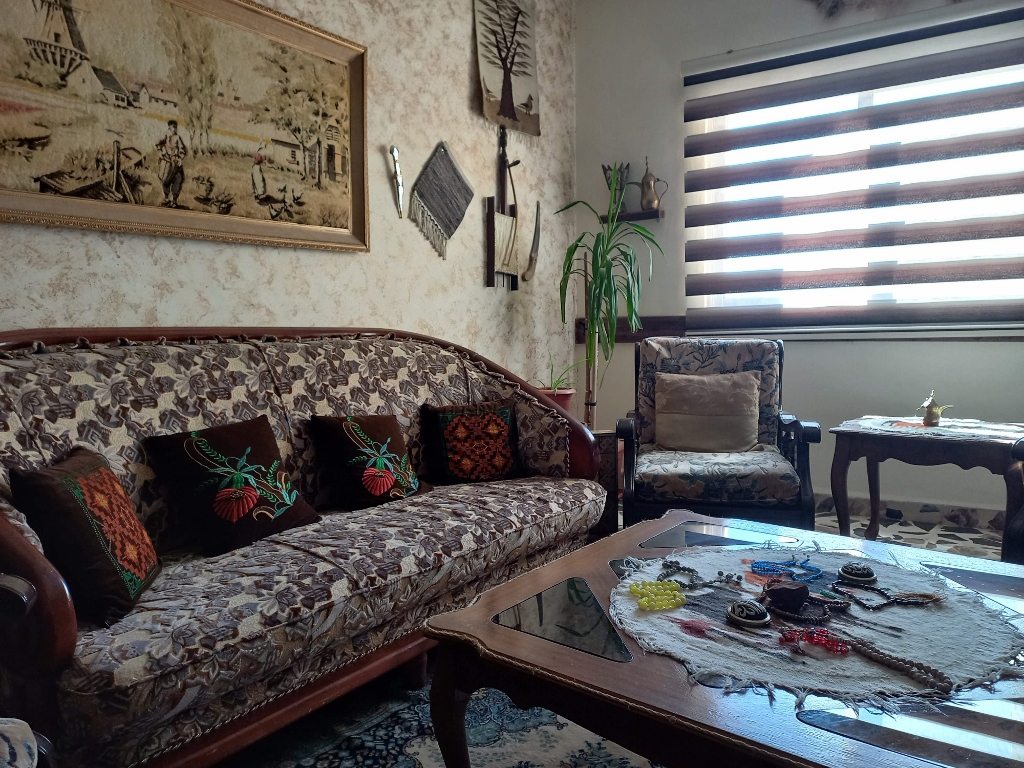 Living room of the B&B in Karak where I stayed
Living room of the B&B in Karak where I stayed
First, let me say that the name of the city is spelled Karak in some places and in some other Kerak. I don’t know how it is written in Arabic, but these are English transcriptions. My original plan did not include Karak at all, but with time I realised that there were remains of some famous castle here, plus the city was in a good position for me to go for some “excursions,” so I decided to make this stop.
As it was still the early afternoon, I thought I could manage to visit Lot’s Cave. In order to do that I first had to go down to the area south of the Dead Sea. I read in my guidebooks that there was public transportation to the town of Ghor es-Safi and this cave I was interested in was very close.
Talking with the B&B owner, through some tough negotiations we reached a deal that he would take me there by his car. The arrangement was that I would pay only for the fuel. There, he seemed to be a kind person. Needless to say, it was clear to me that I would pay for the “fuel” way more than the real cost, but I did not care too much. I wanted to do as I planned.
It was also important for me to provide transportation for the following day in order to visit two more important sites. The first price which (apparently) gave a friend of my landlord (I could not tell who was pumping up the price, the landlord or his friend or both of them) was insultingly high. By this point, I was a woman with ample experience as regards the visiting of Jordan, so I was a tough negotiator. To start with I was very relaxed and with no panic in my voice, so I told him we would see about it later after our own excursion. I thought I could then walk around the city and try to come up with something and it also occurred to me that I could contact a better hotel and ask for their recommendation for the hiring of transportation.
But, let me first go back to this spontaneously created excursion to Lot’s Cave. While I was still in Amman, reading the guidebooks (I used one in English that I bought on the first day, as well as one in Italian that I found in the hotel), I planned to take a local bus to that town south of the Dead Sea and then take a taxi there for a short drive to the site. It was precisely about this that I started to consult with the landlord who told me that this could not be done, since apparently the sunset was early, etc., but I was adamant that it could be done. He gave me again an “indecent offer” by that friend of his, but since I was about to leave on my own, he then offered to take me there himself “for the price of the fuel.” When we agreed about it eventually, I got out to the street in front of the B&B, because that’s where the car was. From there I could see nicely the ramparts of Karak Castle that is perched on the top of the hill.
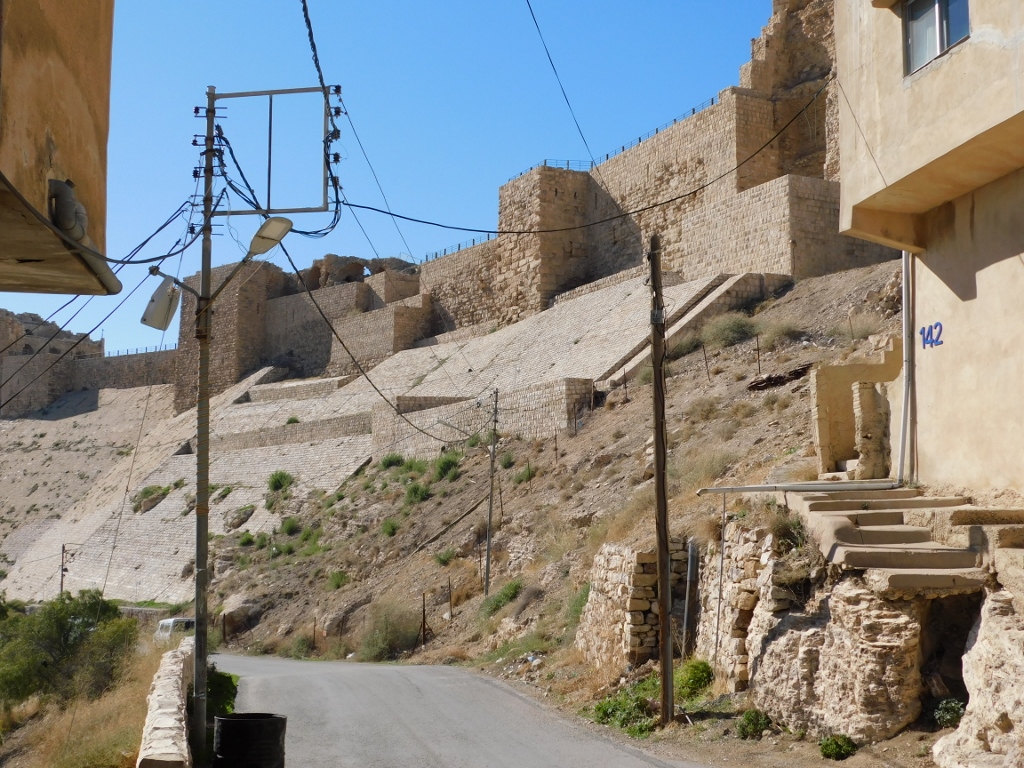 Karak Castle seen from the street in front of the B&B where I stayed
Karak Castle seen from the street in front of the B&B where I stayed
Soon we left and were out of the city, but the impressive castle could be seen from the distance and from the other side as well.
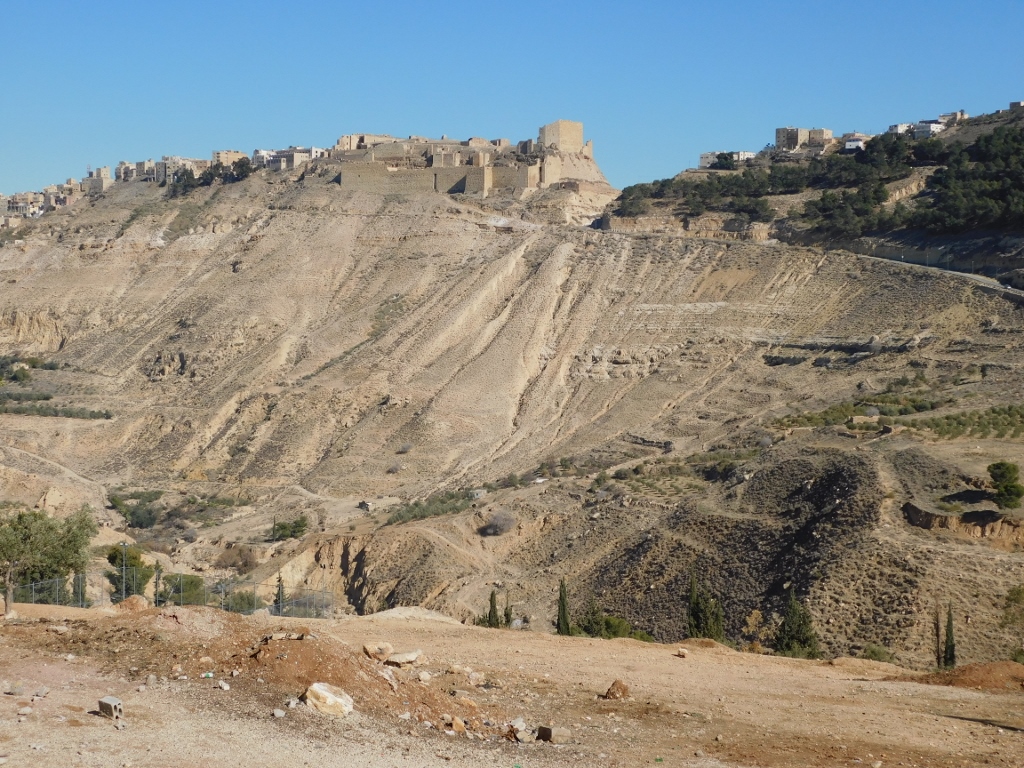 Parts of Karak city with the castle of the same name on the top of the hill
Parts of Karak city with the castle of the same name on the top of the hill
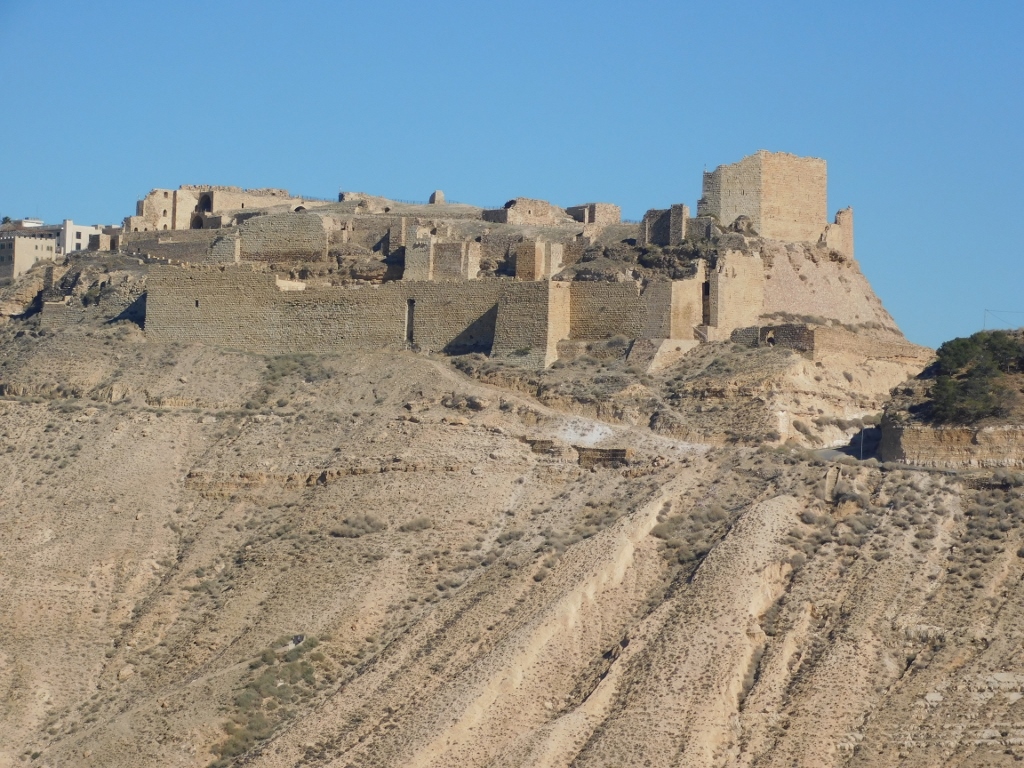 Karak Castle
Karak Castle
I found it interesting that Shriya, the owner of the B&B who was driving me now, chose a totally local road, because we went through some smaller villages and the landscapes around me were very pretty. He offered to make stops in order for me to take photos, but in that way we would never reach our destination, so I mostly took photos from the moving car, although in a couple of places I did ask him to stop.
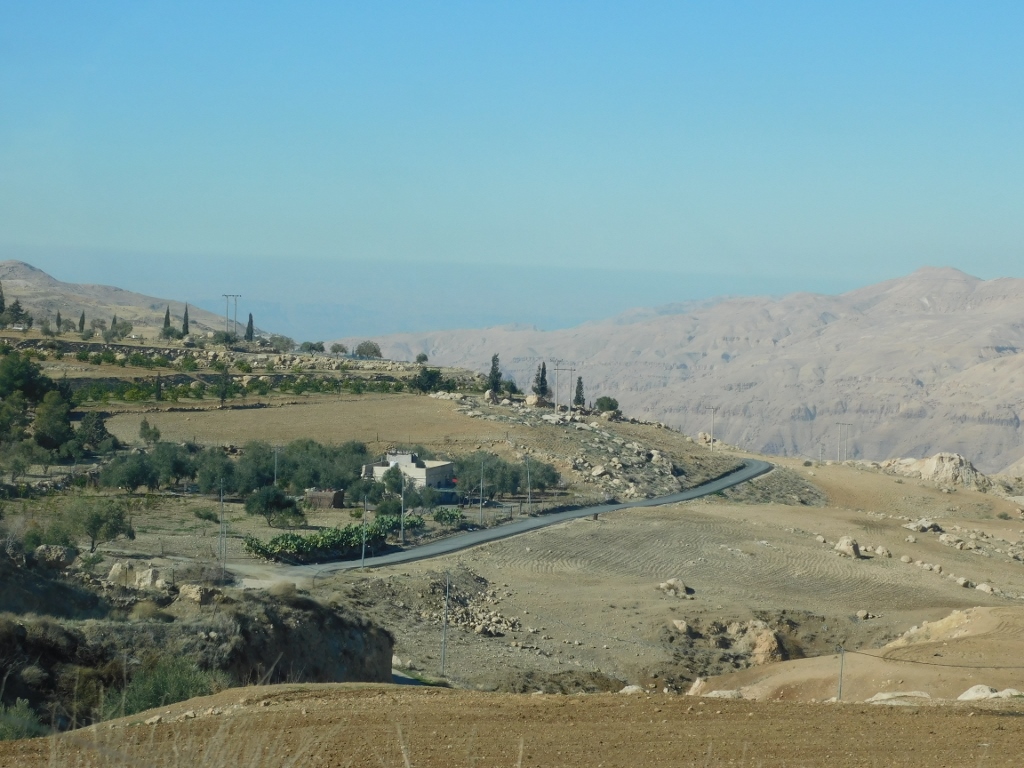 Leaving Karak and heading down to the Dead Sea
Leaving Karak and heading down to the Dead Sea
Karak is situated at the altitude of 1100 m above sea level, while the surface of the Dead Sea is at -430 m, i.e., below the sea level. This means that the altitude difference we covered was around 1500 m, while the length of the road from the city to the main traffic road that goes parallel to the sea in the north-south direction (Jordan River Valley Highway) is around 27 km.
 Landscape as seen from a viewpoint
Landscape as seen from a viewpoint
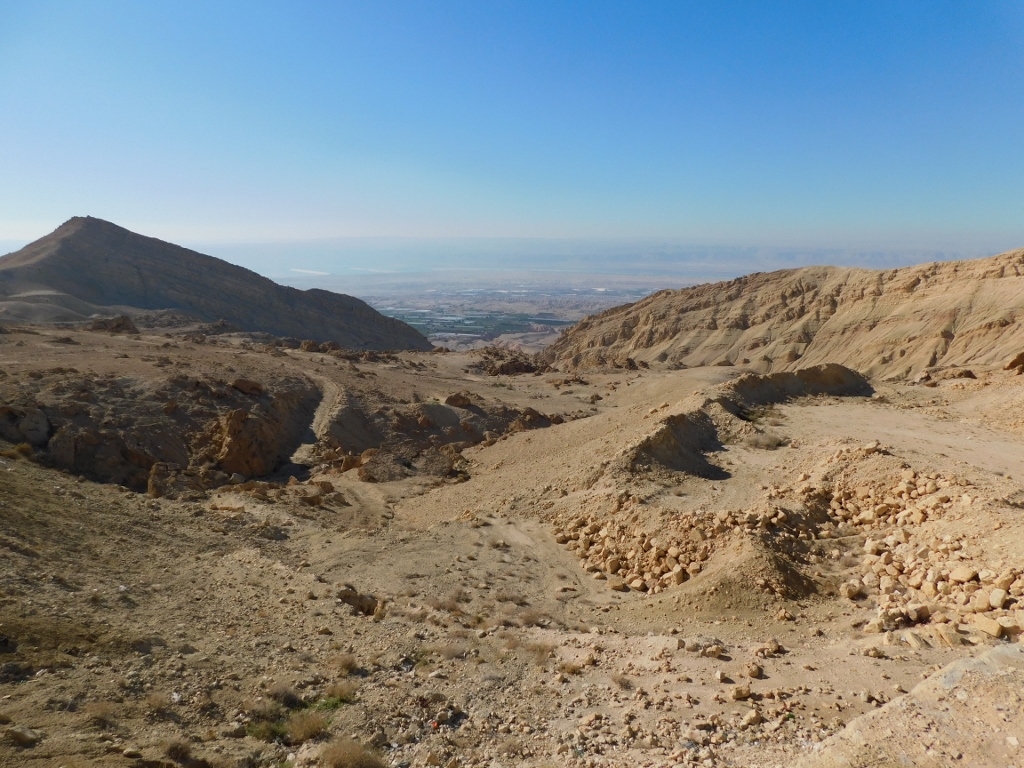 Landscape as seen from a viewpoint
Landscape as seen from a viewpoint
Down in the depression, south of the Dead Sea, I could see numerous green fields, as well as salt evaporation ponds that Jordan has more and more of.
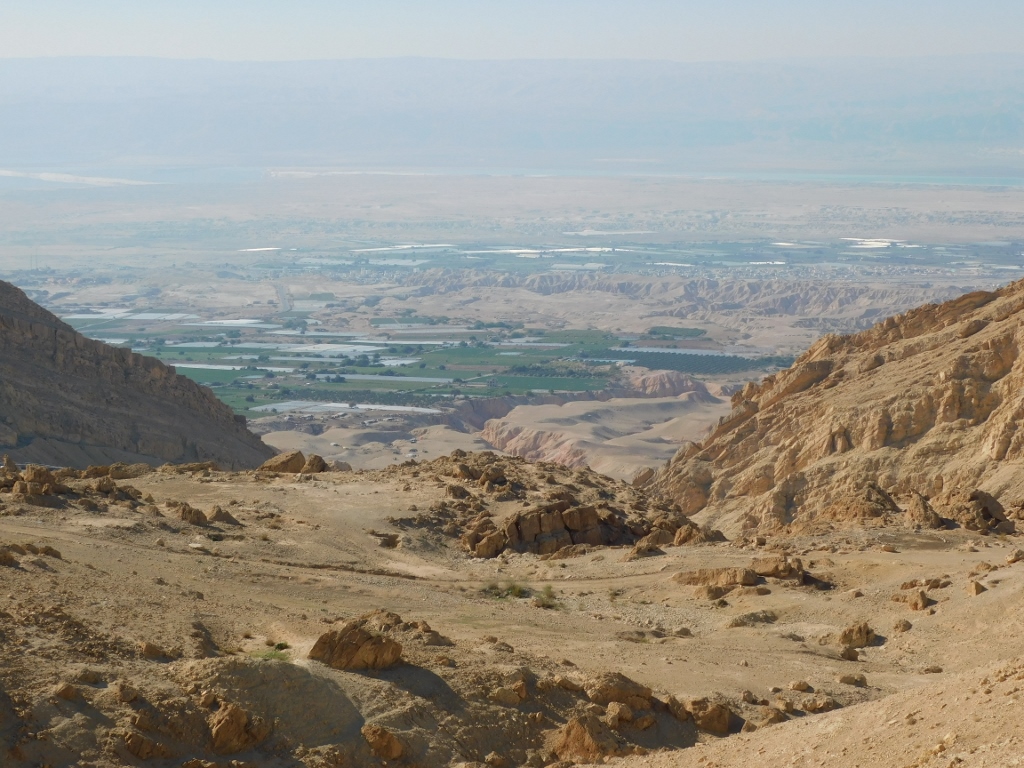 View at the depression in which the Dead Sea is also located
View at the depression in which the Dead Sea is also located
Further towards the northwest, across the heights from which we descended, I could also see the Dead Sea.
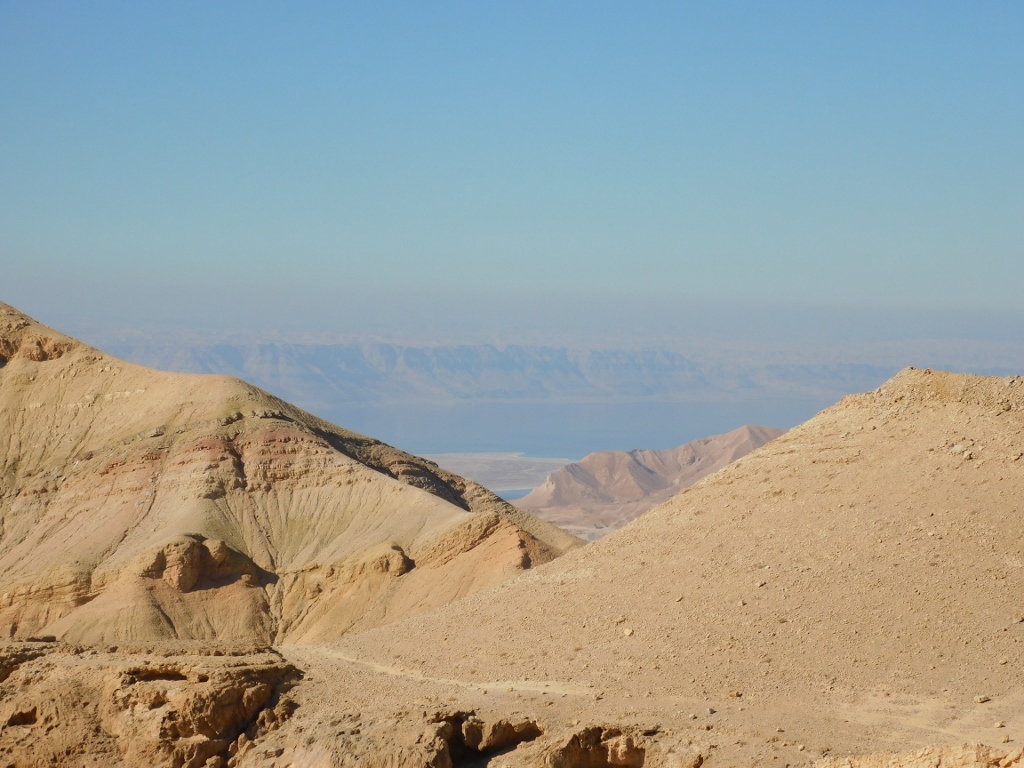 View at the Dead Sea in the distance
View at the Dead Sea in the distance
I found these landscapes to be incredibly beautiful, regardless of the fact that we were mostly passing between barren, rocky mountains, while in the distance I could see green fields and large water surfaces used in the salt production.
Descending from the height at which Karak is located was even steeper than what one could think, because before reaching the Jordan River Valley Highway there is also an interesting, but flatter area filled with low hillocks.
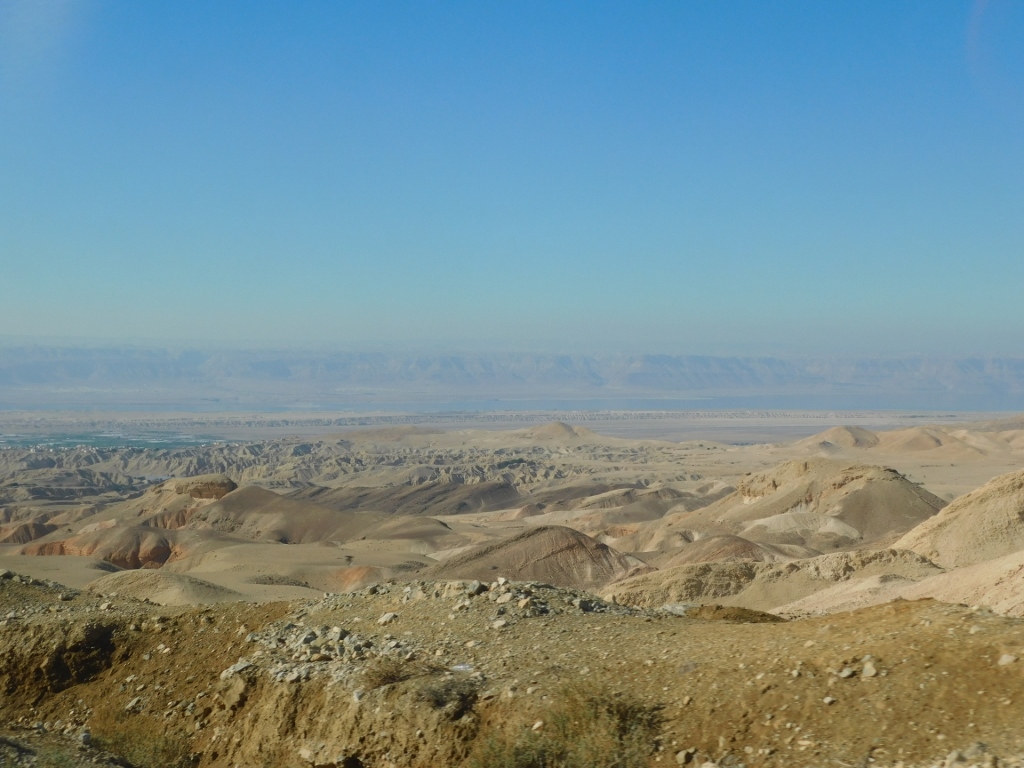 View at the Dead Sea in the distance; even farther away is Israel
View at the Dead Sea in the distance; even farther away is Israel
More to the south, one can see these numerous salt evaporation ponds.
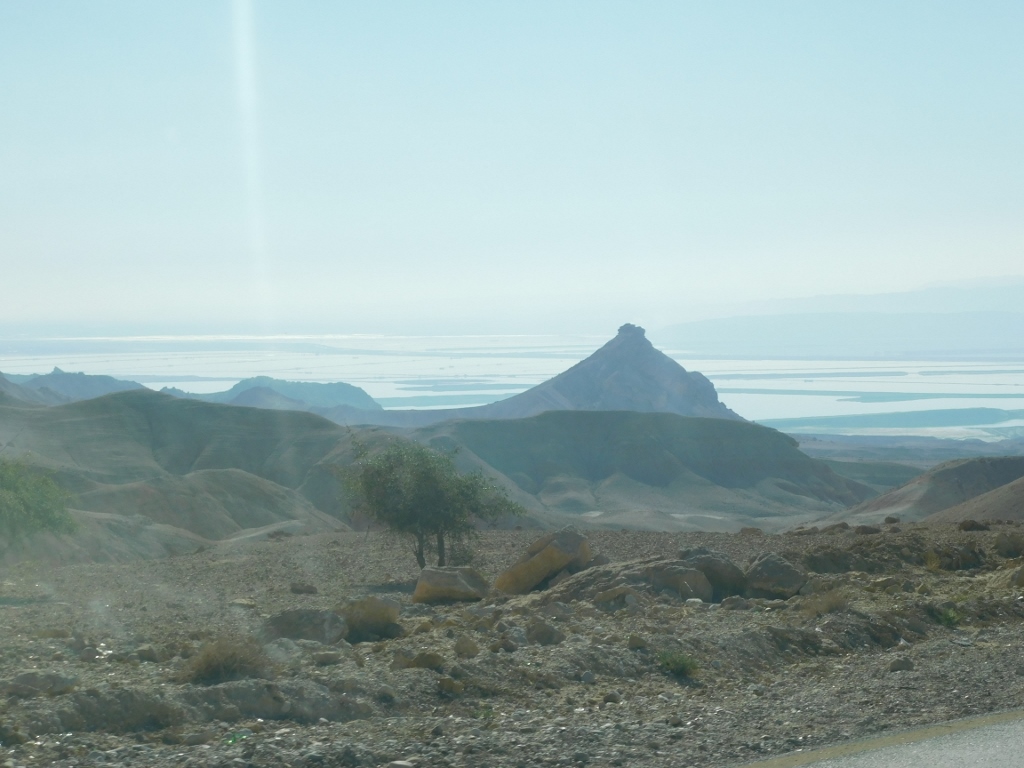 View at the area south of the Dead Sea where there are numerous salt evaporation ponds
View at the area south of the Dead Sea where there are numerous salt evaporation ponds
Before reaching the motorway, we stopped at a petrol station and while Shriya dealt with the fuel, I looked at the surroundings. And so I noticed some Bedouin tents.
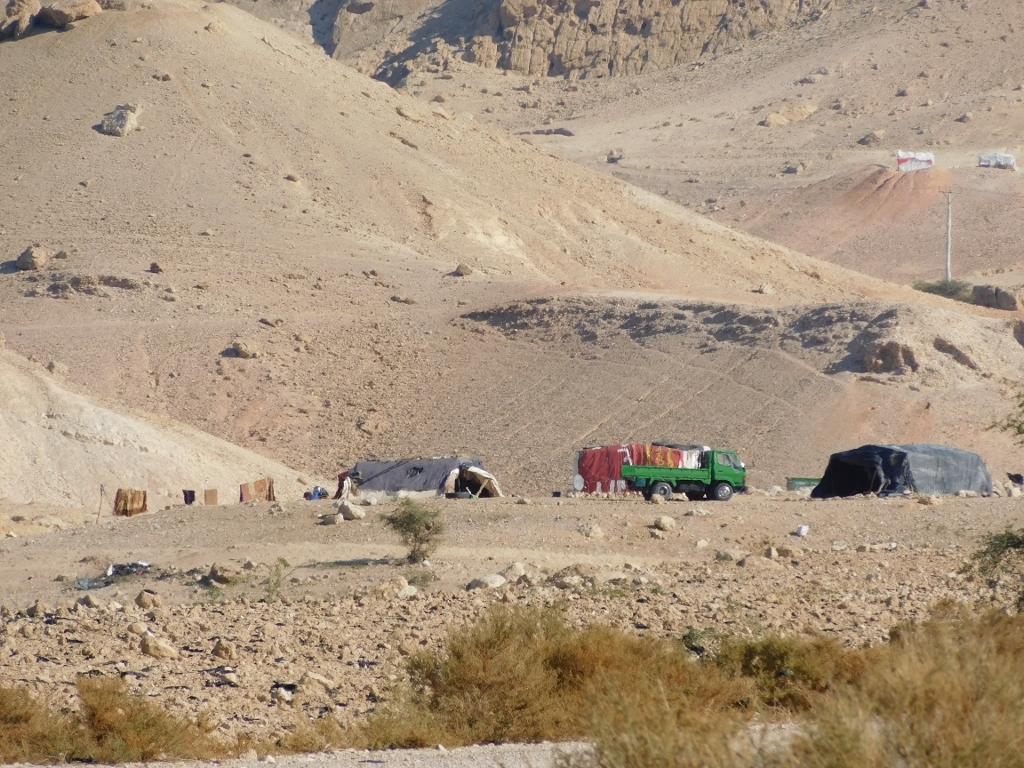 Bedouin tents near the road
Bedouin tents near the road
As it could be seen from my previous photos, irrespective of the altitude, the flat areas south and around the Dead Sea are rather fertile and humans have been using them for millennia. Although the winters are very mild here, the temperatures during summers are extremely high, but precisely these additional 400 m in height help alleviate the harmful effects of the sunrays. The Dead Sea is practically a salty lake and there is no life in it, but there are numerous freshwater springs around and this allows in the present times to grow different plants, such as dates, sugarcane, tomatoes, etc. Also, there are deposits not only of salt here, but also of bitumen, sulphur and potash, so this is produced as well.
At some point, we moved to that main road that is officially designated as a highway, although it is not really, and we continued along it towards the south and the town of Ghor es-Safi, usually called just Safi. Before the town itself, there is turn that leads to the Museum at the Lowest Place on Earth. This is its official name.
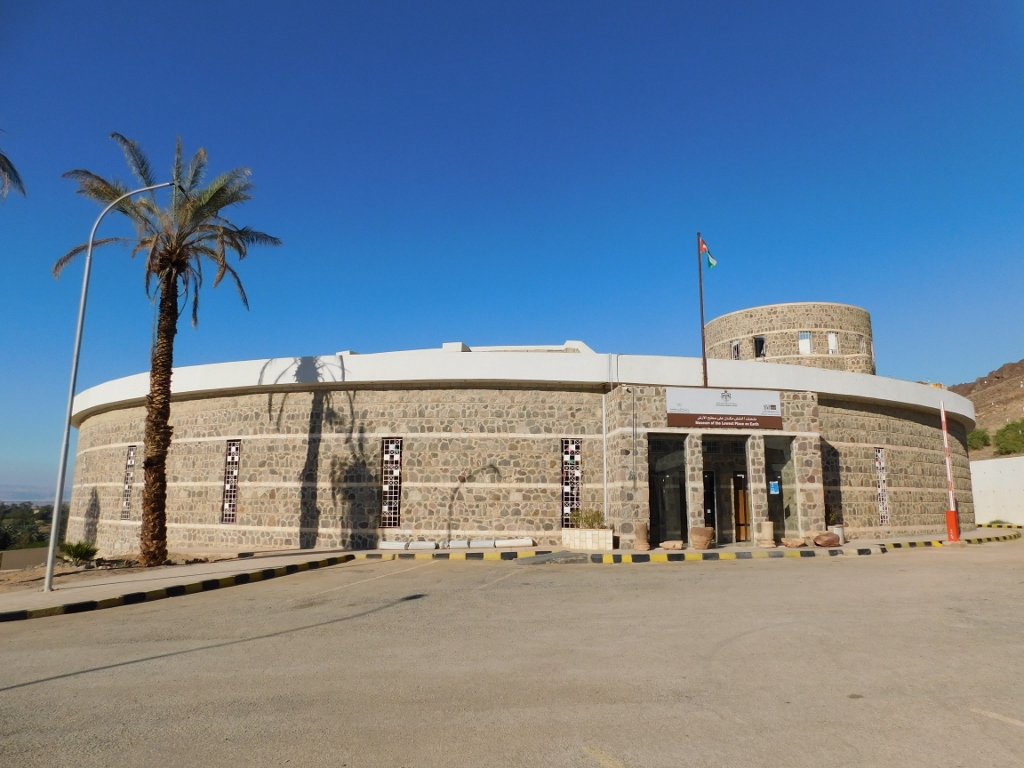 Museum at the Lowest Place on Earth
Museum at the Lowest Place on Earth
During the archaeological excavations of the Sanctuary of Lot, an idea came up in 1996 to build a museum in this place. Namely, numerous artefacts were found here and the site was declared a Holy Place in 1995, plus it is also located at impressive 300 m below the sea level.
Among other exhibits, the museum shows conserved specimens of textile found in a necropolis. This helps the researchers establish how the inhabitants of the Dead Sea coastline dressed in the period between the 1st and the 3rd century CE. Also, over time, mosaics from the 4th century BCE, in other words those made under the influence of Hellenism, were also found. At that time, the craftsmen mostly used river pebbles, but the technique of making mosaics certainly advanced during the Roman and the Byzantine periods.
I visited the museum briefly and then together with the landlord from Karak who drove me here I headed towards Lot’s Cave. We tried to do that by car, but the road was under construction and that was not good for the rather old vehicle, so I continued on foot, while Shriya first drove the car back to the museum parking lot and then caught up with me.
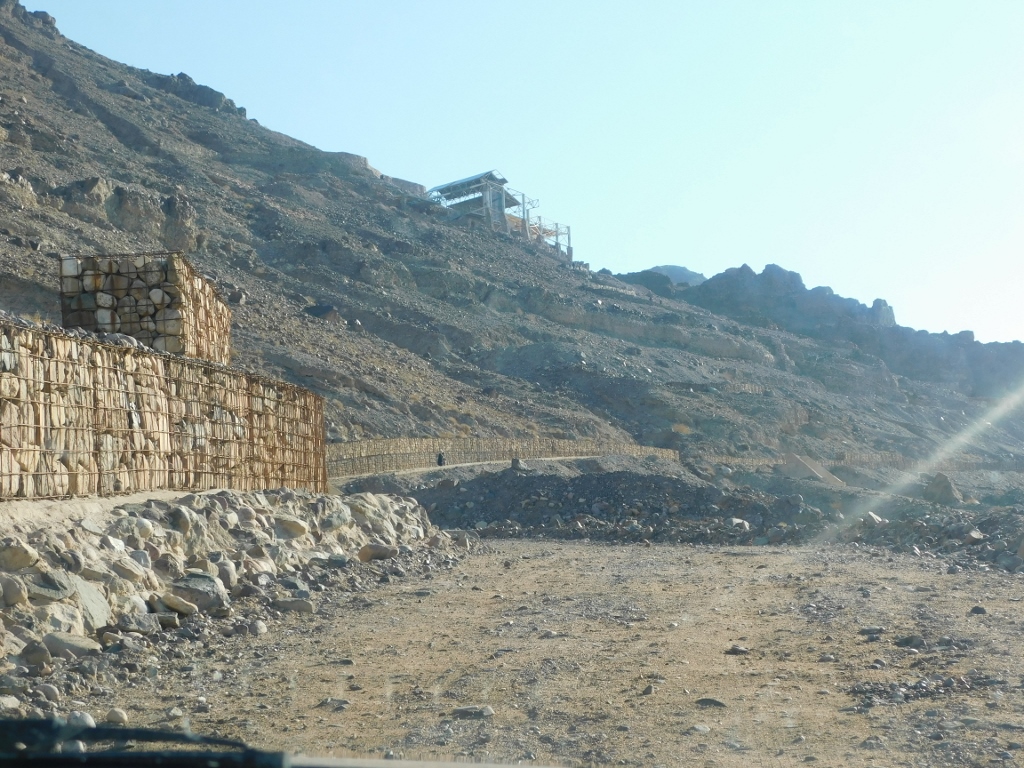 Road under construction; a structure with canopies at Lot’s Cave is seen uphill
Road under construction; a structure with canopies at Lot’s Cave is seen uphill
As I ascended slowly, I often admired the fertile and flat terrain with numerous fields and plantations, as well as salt evaporation ponds.
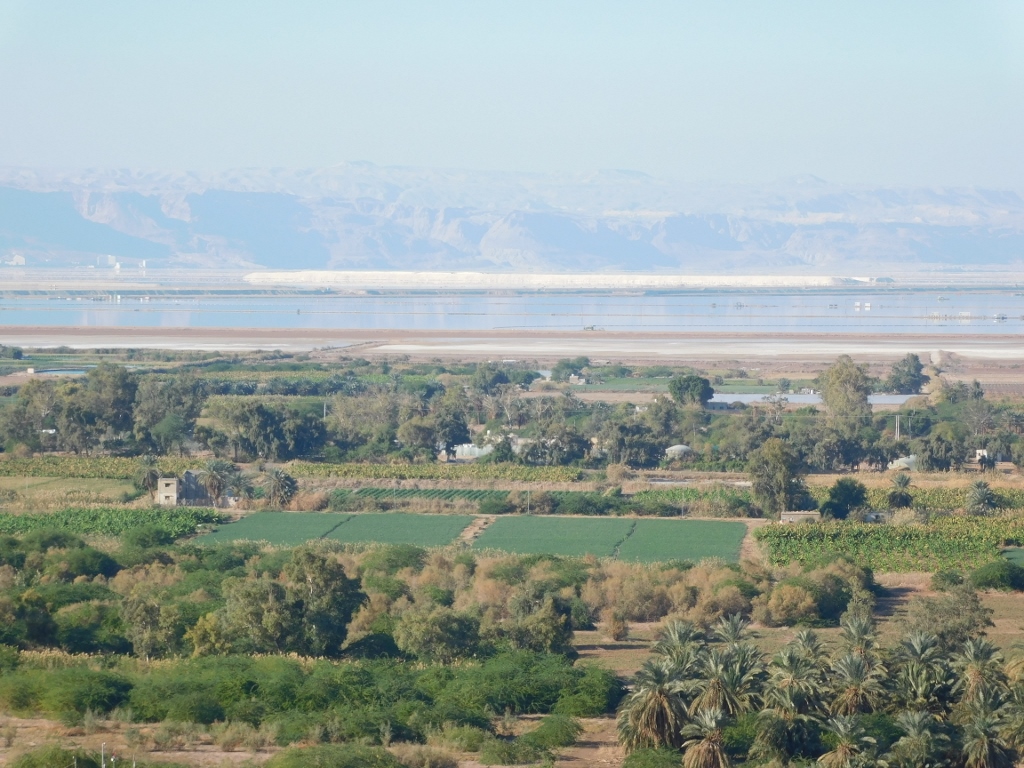 Area south of the Dead Sea, but in the same depression
Area south of the Dead Sea, but in the same depression
 Landscape below Lot’s Cave: the road under construction is in the foreground, the museum is to the right, while the fertile areas, the salt evaporation ponds and Israel are in the distance
Landscape below Lot’s Cave: the road under construction is in the foreground, the museum is to the right, while the fertile areas, the salt evaporation ponds and Israel are in the distance
But, even when the road gets finished one day, there will still be a section that will have to be covered on foot.
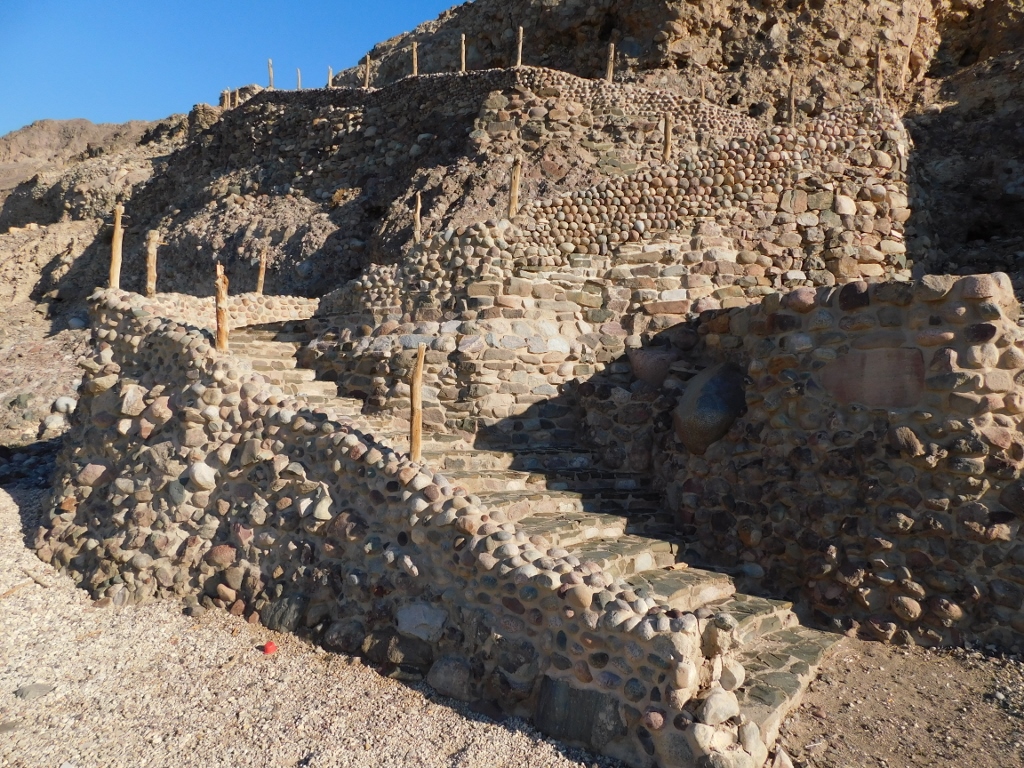 Steps leading to Lot’s Cave
Steps leading to Lot’s Cave
According to the Bible accounts, the cities of Sodom and Gomorrah were located right in this area. Well, there were a few more other cities of the same kind, but these two topped the cake. All sorts of things went on there – parties, razzmatazz, debauchery of all kinds, etc. All in all, the God had enough of looking at these decadent sights and such quantity of sins, so he decided to take things into his own hands. Still, Lot (Abraham was his uncle), together with his wife and two daughters, had a good standing with the ultimate authority, so the angels dropped him a hint when he should get away. And so he did, but his wife, like any typical woman, at least the Bible says so, was curious and she turned back to see what they were leaving behind (although this was apparently strictly forbidden) and there on the spot she turned into a column of salt. Near the east coast of the Dead Sea there is a column of salt called Lot’s Wife; moreover, there is such a place in Israel as well, on the west coast of the Dead Sea.
Be as it may, Lot continued on with his two daughters and they hid precisely in this cave which I came here to see. The legend further says that Sodom and Gomorrah (as well as the other settlements with the same local habits) were razed to the ground and since it was believed that this was the whole world, the human kind came down to these three individuals. Then the daughters, in order not to stay without children, decided to get their father drunk and take advantage of his body, which they apparently did, and later on they gave birth to a son each. Well, now... talking about sins, in my book incest is positioned very high up, plus when you add making an innocent man drunk, cheating, etc. ... To start with, these two daughters obviously missed the night life from S&G or at least they learned a lot back there which they applied in their further life. Of course, there is also a very logical question here – if they gave birth to a son each, where were the women to continue the human kind with? But, I’m certainly overdoing it with logic here – this is all just a question of a legend and everybody can interpret that in whichever way they like.
All in all, in the place where they allegedly hid, a sanctuary was built over time.
The site is located in the area of the southeast section of the Dead Sea on a steep rocky slope and it is mentioned in the 6th century floor mosaic that I wrote about describing my visit to Madaba as the Sanctuary of Saint Lot next to Zoara (https://www.svudapodji.com/en/jordan-1/). By the way, Zoara is the biblical name for the town of Safi.
Still, the archaeological explorations showed only in 1986 that there were remains of a monastery here. This was followed by excavations, which eventually led to the construction of the museum. The Sanctuary of Saint Lot or Lot’s Cave for short includes a Byzantine monastery complex with numerous hermit caves made in the rocky mountain slope.
The main segment comprises remains of a church with three apses built around a natural cave which early Christians believed to be exactly the place where Lot and his daughters hid. On the floor of the church it is possible to discern two dates: April 606 and May 691 CE.
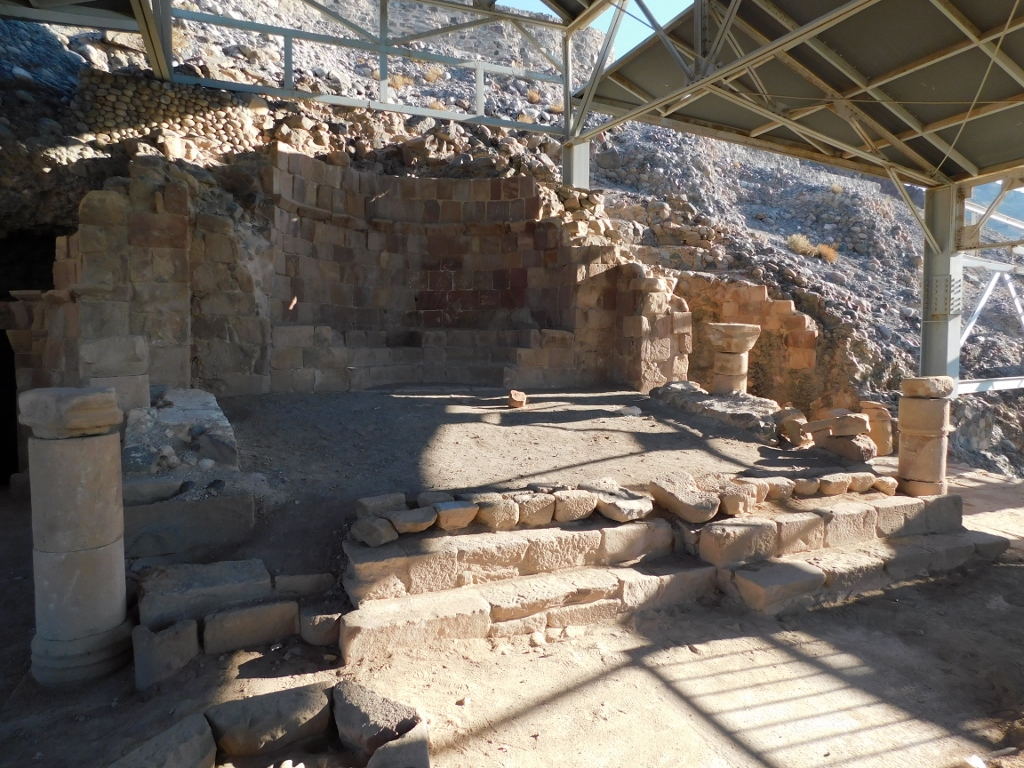 Remains of the central naos of the Byzantine church
Remains of the central naos of the Byzantine church
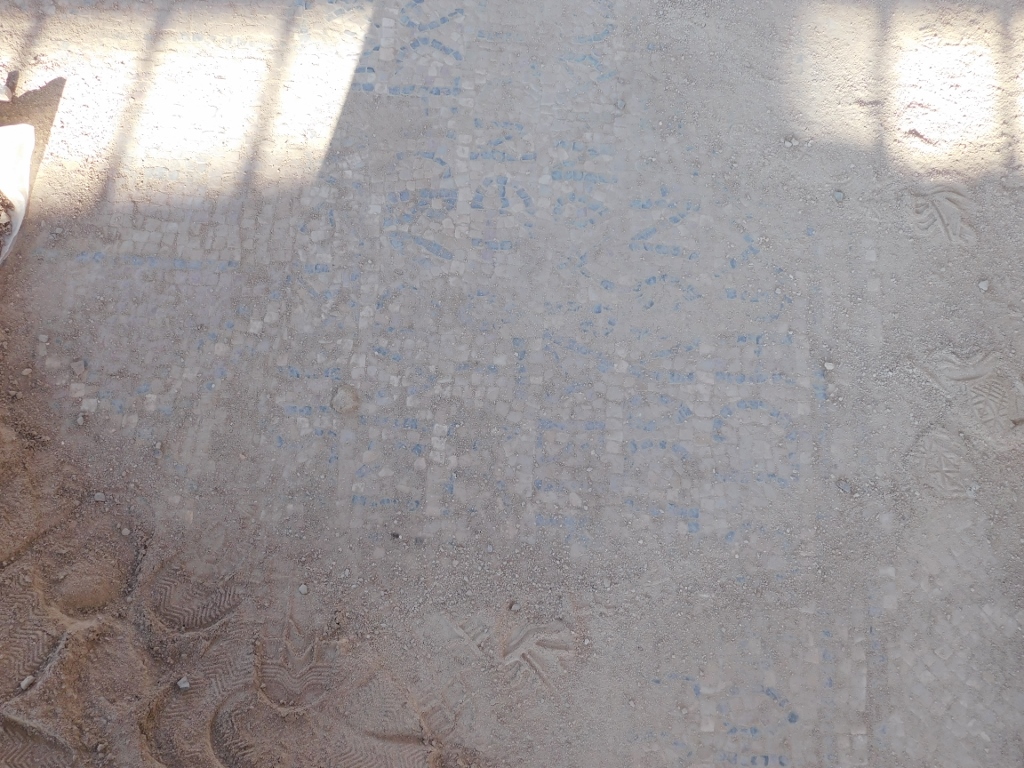 Part of the floor mosaic of the Byzantine church
Part of the floor mosaic of the Byzantine church
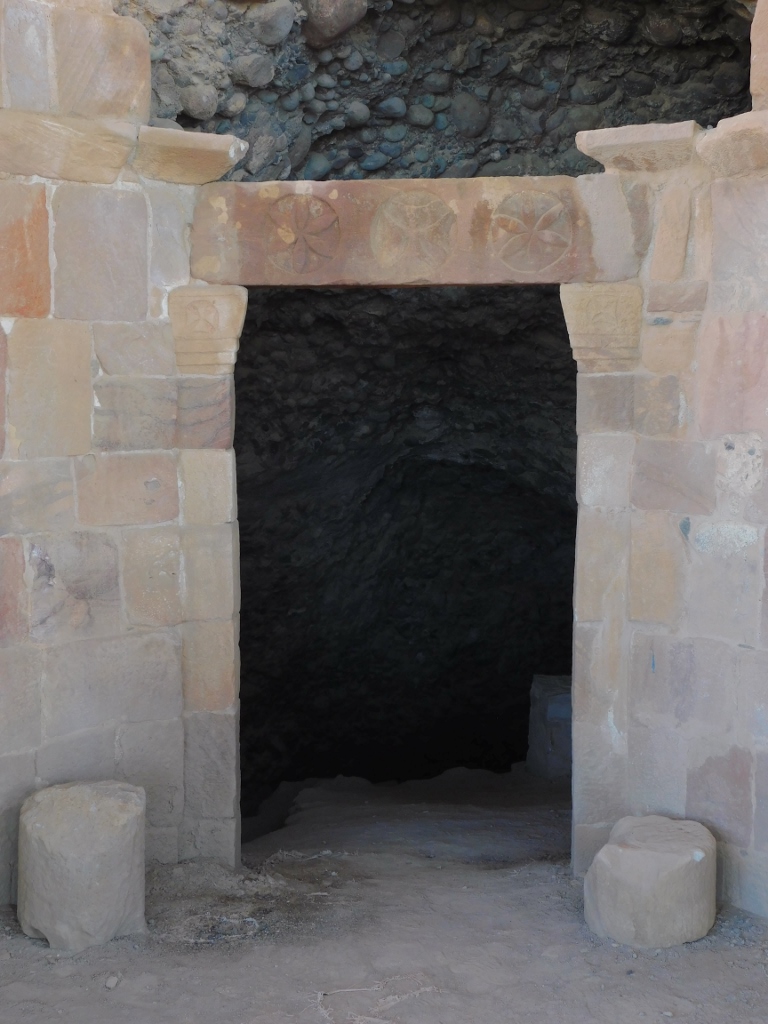 The cave is entered through the back wall of the left-hand apse
The cave is entered through the back wall of the left-hand apse
Needless to say, I had to go into the cave, but it is just a very short and quite narrow cave, more like a passage, so soon I crawled out of it.
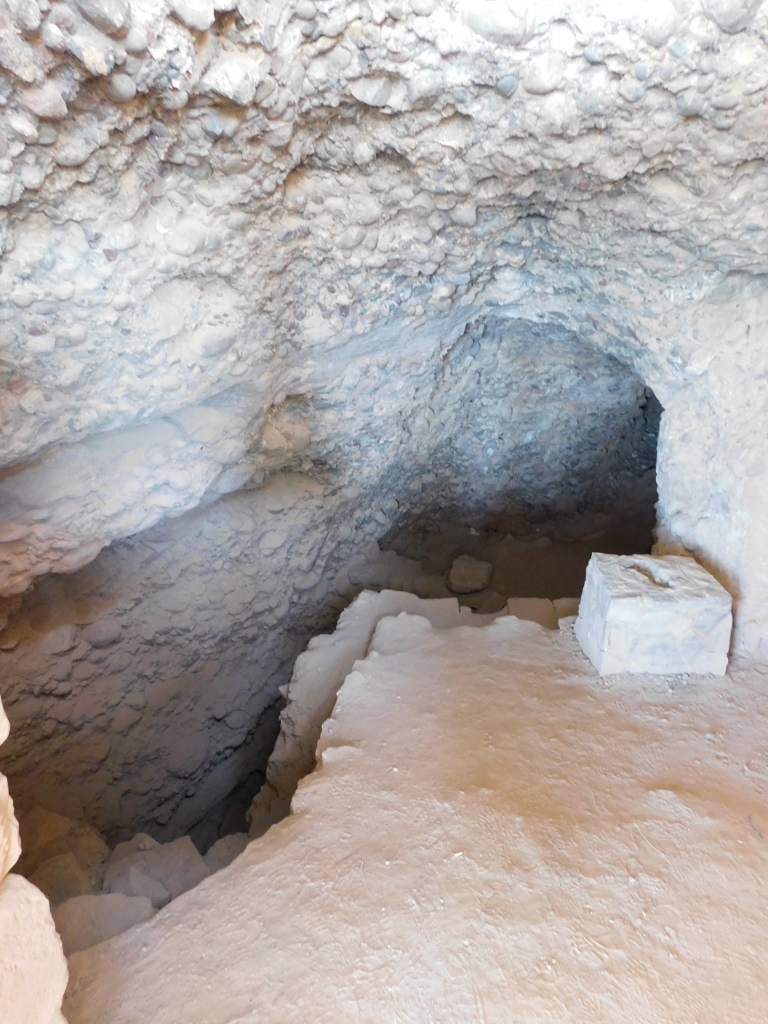 Lot’s Cave
Lot’s Cave
Beside the remains of the right-hand apse, there is also a large water cistern.
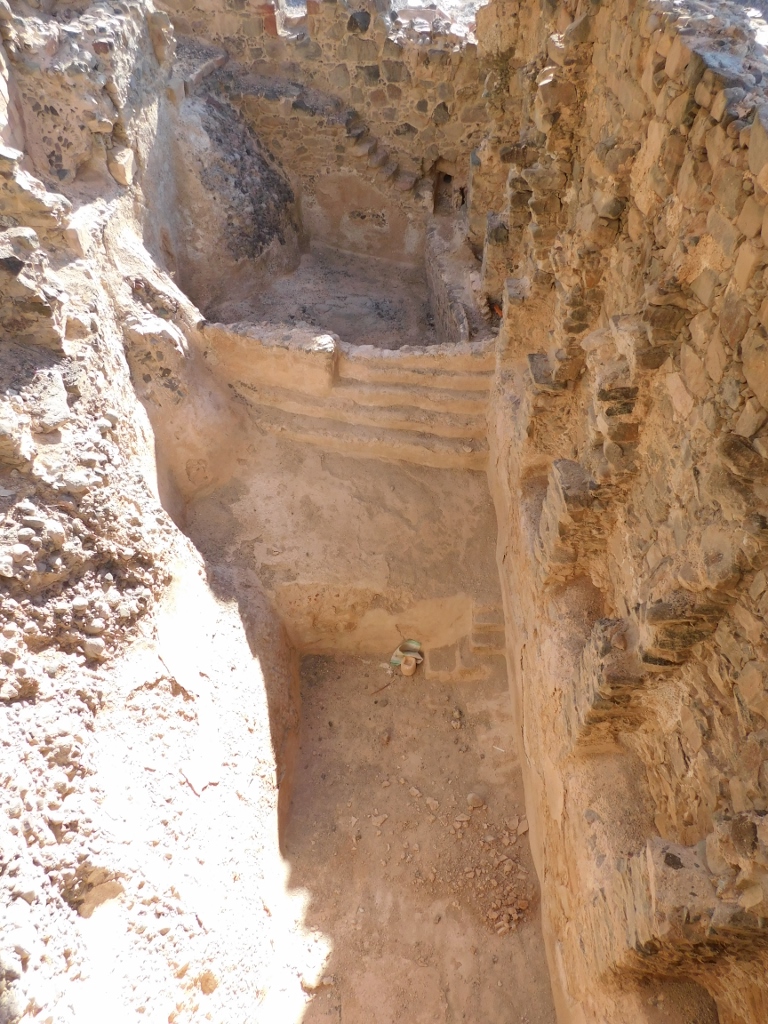 Water cistern
Water cistern
In addition to the artefacts from the early Byzantine period, pottery from the period from the 1st century BCE to the 1st century CE, as well as graves from 3000 BCE and from the period 2000-1500 BCE have been found. The latest settlement in this place existed at the end of the 8th century and the beginning of the 9th century during the Abbasid Caliphate.
While I was visiting this site, there was a group of men of different age. At some point they asked me to take a photo of them using MY camera. As it turned out, they were from Pakistan and that reminded me of India which I love so much and the inclination of the Indians, and apparently also of the Pakistanis, to have their photo taken. I’ve never really understood this, but I have always been delighted and was ready to oblige. Same thing here.
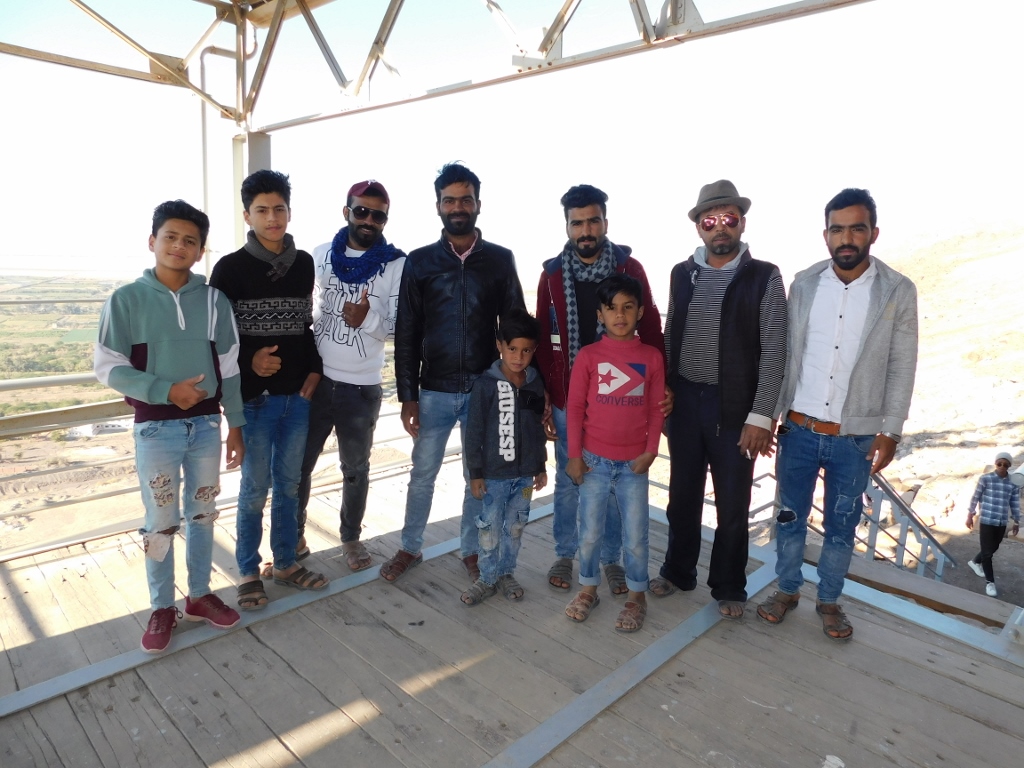 Group of Pakistanis who like having their photo taken
Group of Pakistanis who like having their photo taken
From a platform made in front of the sanctuary there was again a splendid view at the areas south of the Dead Sea.
 View from the platform by the Sanctuary of Saint Lot
View from the platform by the Sanctuary of Saint Lot
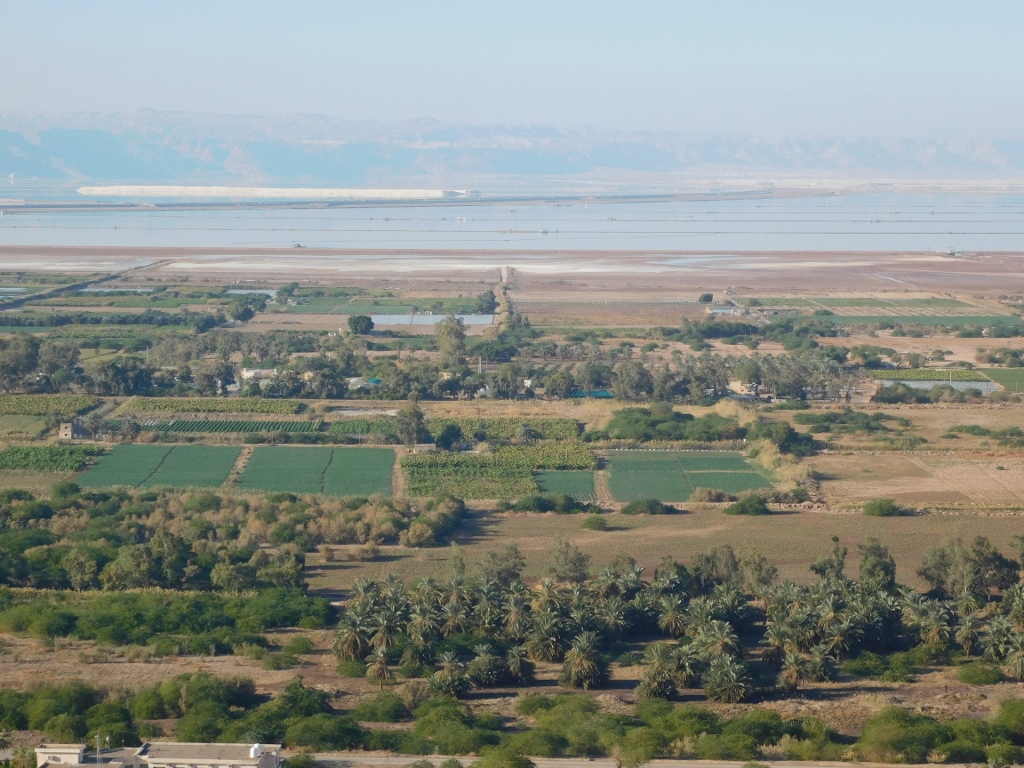 View from the platform by the Sanctuary of Saint Lot
View from the platform by the Sanctuary of Saint Lot
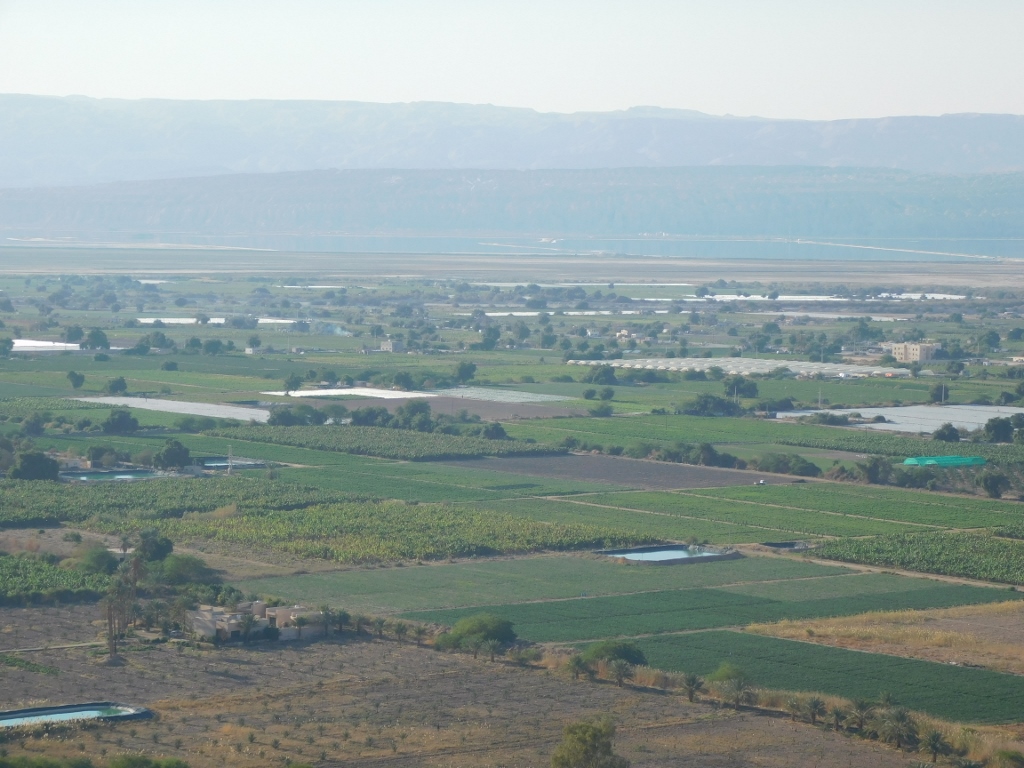 View from the platform by the Sanctuary of Saint Lot
View from the platform by the Sanctuary of Saint Lot
But, there were also steps that I had to follow in order to get to the road under construction and then go back to the parking lot by the museum where the car that was to take me back to Karak was.
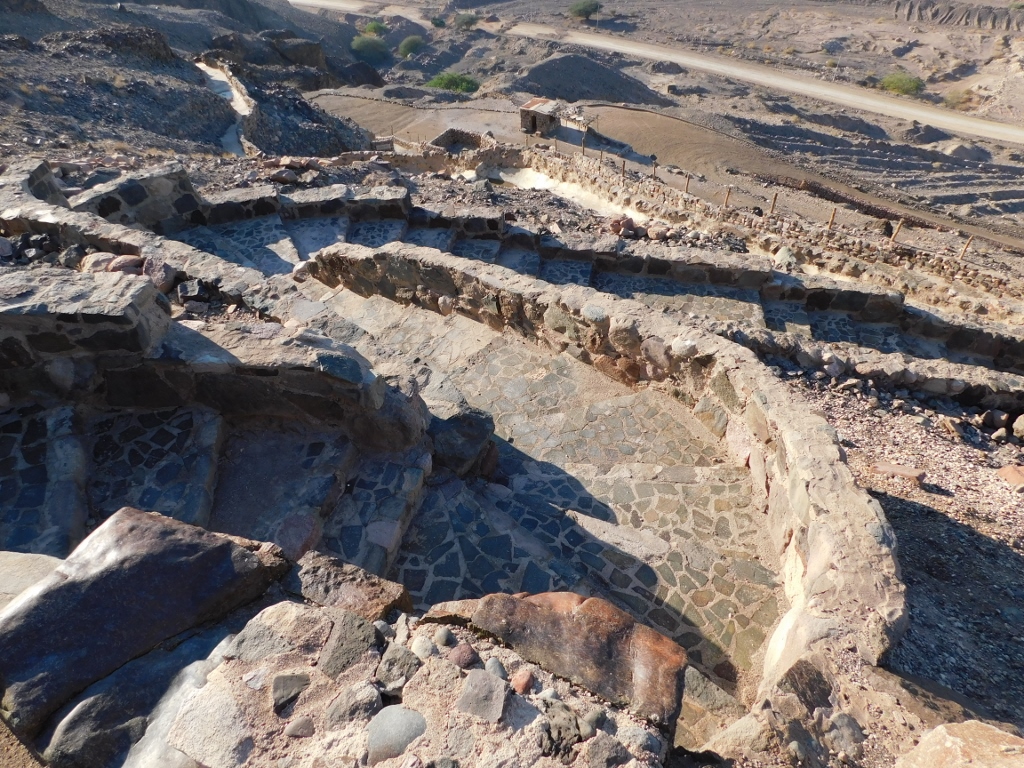 Steps by the Sanctuary of Saint Lot
Steps by the Sanctuary of Saint Lot
Along the way we also drove past some industrial facilities linked to the mining of the ores I’ve mentioned and not far from the road there were some more Bedouin tents.
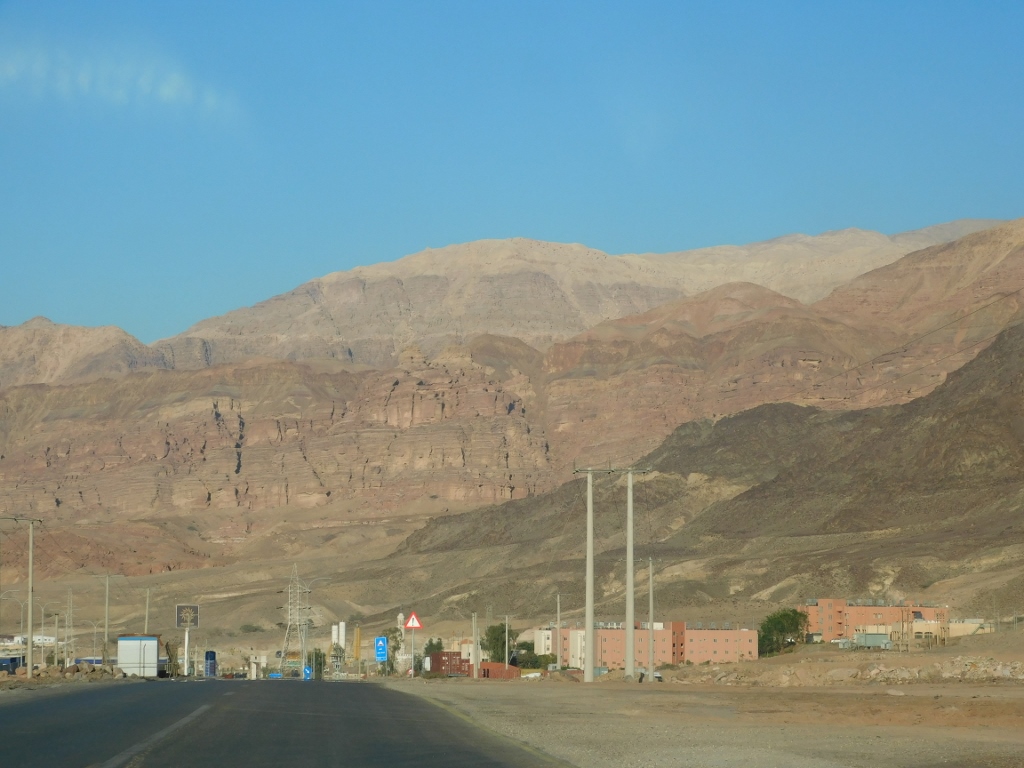 Sights beside the road
Sights beside the road
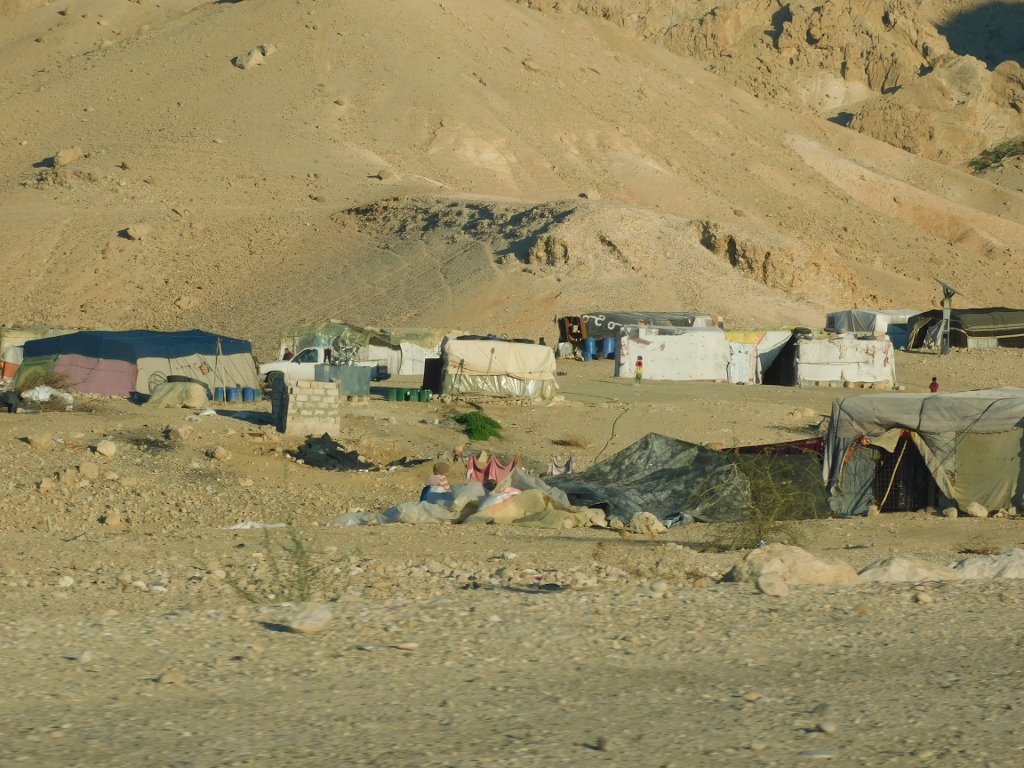 Sights beside the road
Sights beside the road
When we returned to the B&B, Shriya offered that we dined together. His friend just made maqluba which is one of the specialties in this region. I accepted gladly, but let there be no mistake, I paid for my dinner. I did not mind it in the least, but what I want to say is that although Jordanians are famous for their hospitality, this thing here was pure business.
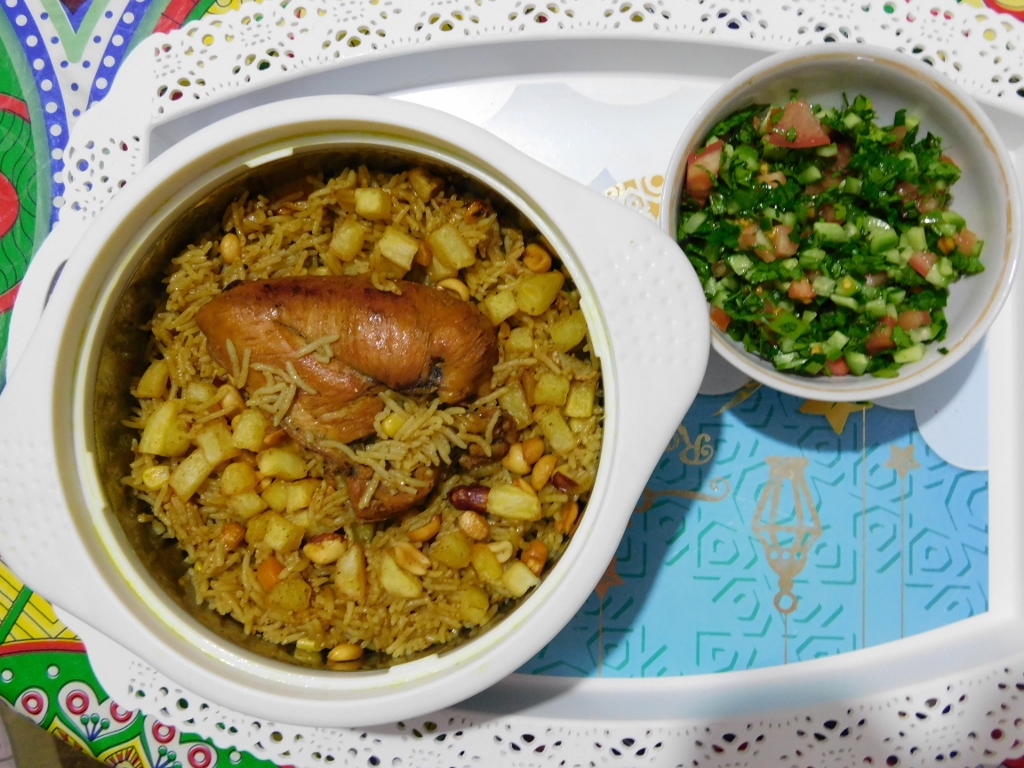 Maqluba and tabbouleh
Maqluba and tabbouleh
After I had returned home, I made my own version of maqluba and I must admit I was most content. Although it is traditionally made with lamb, in Karak I ate the version with chicken, so I used that kind of meat. Here is the photo and the recipe:
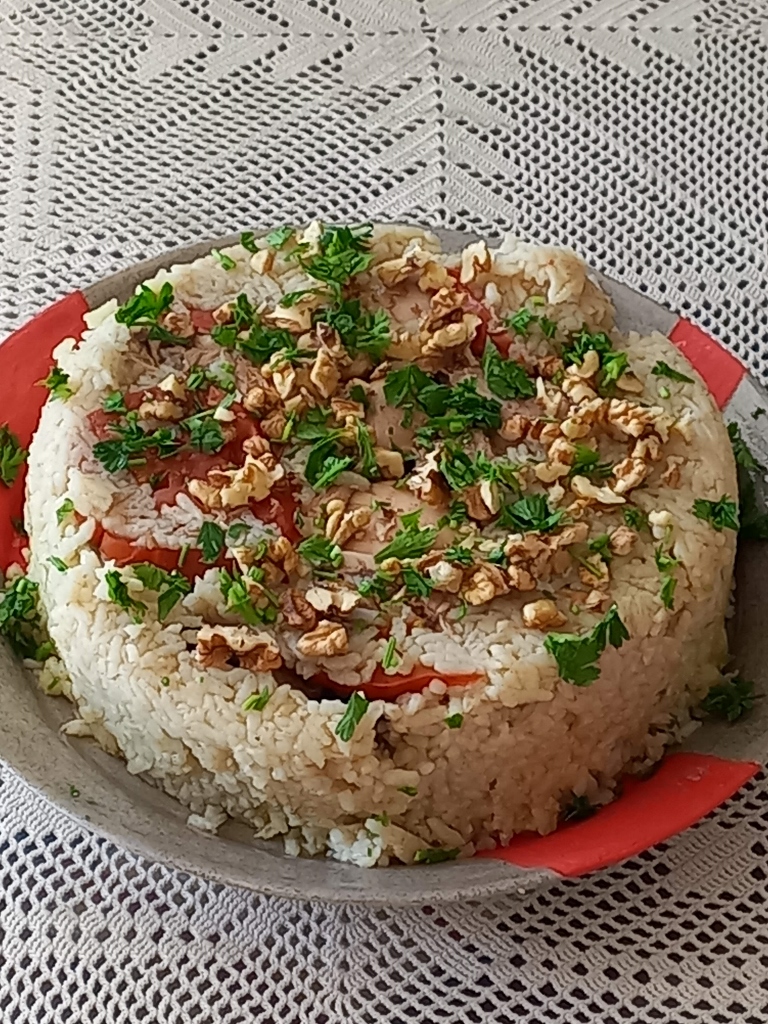 Maqluba made my way and served on a plate that I have made myself
Maqluba made my way and served on a plate that I have made myself
MAQLUBA WITH CHICKEN
- 2 deboned chicken legs
- 1 onion
- 1 tomato
- 1 smaller aubergine
- 1 green pepper
- 1 cup of rice
- 2 cups of chicken stock
- a handful of chopped walnuts
- spices from the recipe and according to the taste
The meat should be seasoned with salt and pepper, and it is also possible to use a spice mixture for chicken.
The onion should be finely chopped, the tomato and aubergines should be sliced, and the pepper cut into pieces.
On a hot pan with some oil fry the meat. It is important that the meat gets some crust without being fully fried. When it’s easy to move it in the pan, turn the mean and fry it on the other side, too. The meat in the middle will not be fully fried. When it’s again easy to lift the piece of meat from the pan, take it out and put it in the middle of a greased metal or ceramic dish with a lid that will later go in the oven. Arrange slices of tomatoes around the meat.
In the same pan fry the aubergines and the peppers. You can add ground black pepper, thyme, etc, but you should not salt too much. Once this has been fried a little, take it out of the pan and arrange over the meat and tomatoes.
Now put the onions to fry in the pan, adding some oil if necessary, but also pour in some water or stock in order for any sticking bits of meat and vegetables to detach from the pan. Once the onions have been fried arrange it over the meat and vegetables.
Rinse the rice and ten put it over the meat and vegetables, flattening it with a spoon. Then pour in the stock to which you have added turmeric or cumin. All according to your taste.
Cover it and put it in the oven at 190 degrees C, until the rice has absorbed all the stock. Take it out of the oven and leave it covered for a short while. Then take the lid off, cover the dish with a larger plate and quickly flip it over. The maqluba should fall out of the baking dish, so that the meat and the tomatoes are now on the top. Sprinkle with chopped walnuts and parsley.
As for the rest of my stay in Karak, when later in the living room I browsed on the internet, it occurred to me to look up the number of a hotel where I could inquire about the hiring of car and driver for the following day, but as it turned out only one establishment seemed professional enough. While I was sitting there in the cosily warm room together with the landlord, he asked me what I would do the next day and I just casually dropped the name of the hotel I was about to call (I was not sure at all it would function like that, but that was the only option that I thought of). He could see that I was quite serious in my intention, so he asked me how much I paid for my excursion in Amman. I gave him the example of the last case (and I didn’t lie about it), after which I also showed him on the map, making a route and calculating the distance, telling him the duration of the excursion and that I got a brand new hybrid car. Just so that he knew he could not give me some crappy old car for a lot of money, not because I cared about it. In the end we quickly agreed about the price that was almost three times lower than the first one he offered. I was pleased. Mostly because I would go where I wanted and planned for the following day and because I would not have to reshuffle my travel plans which were actually shaping up quite nicely.